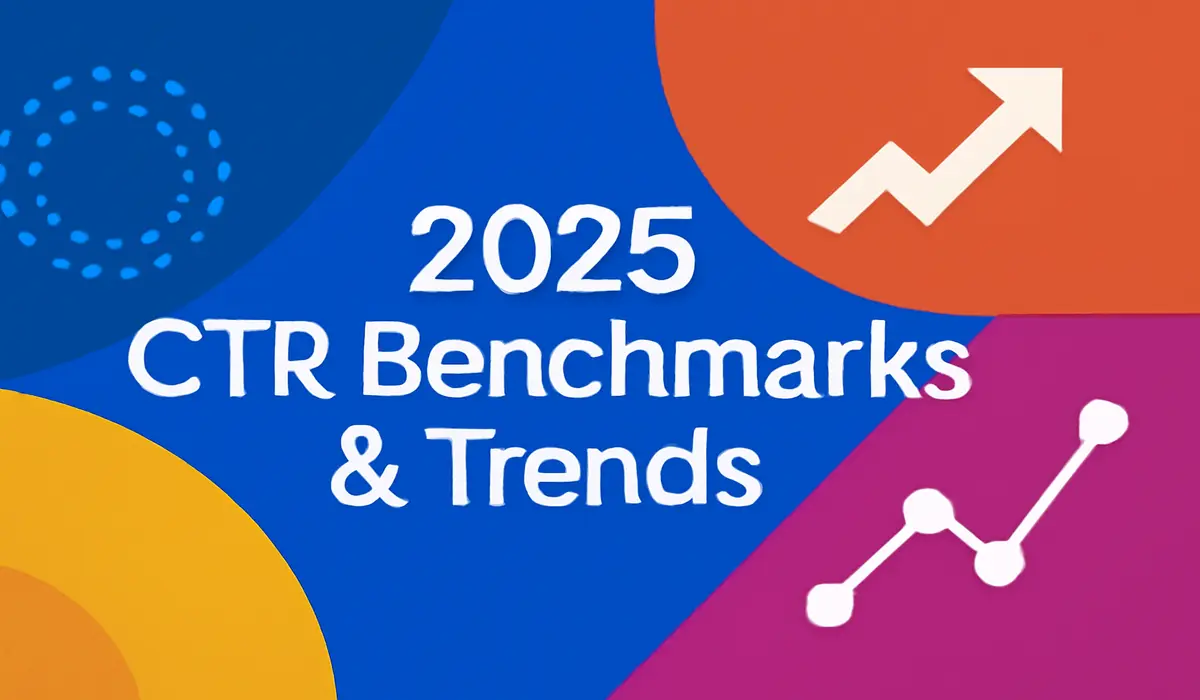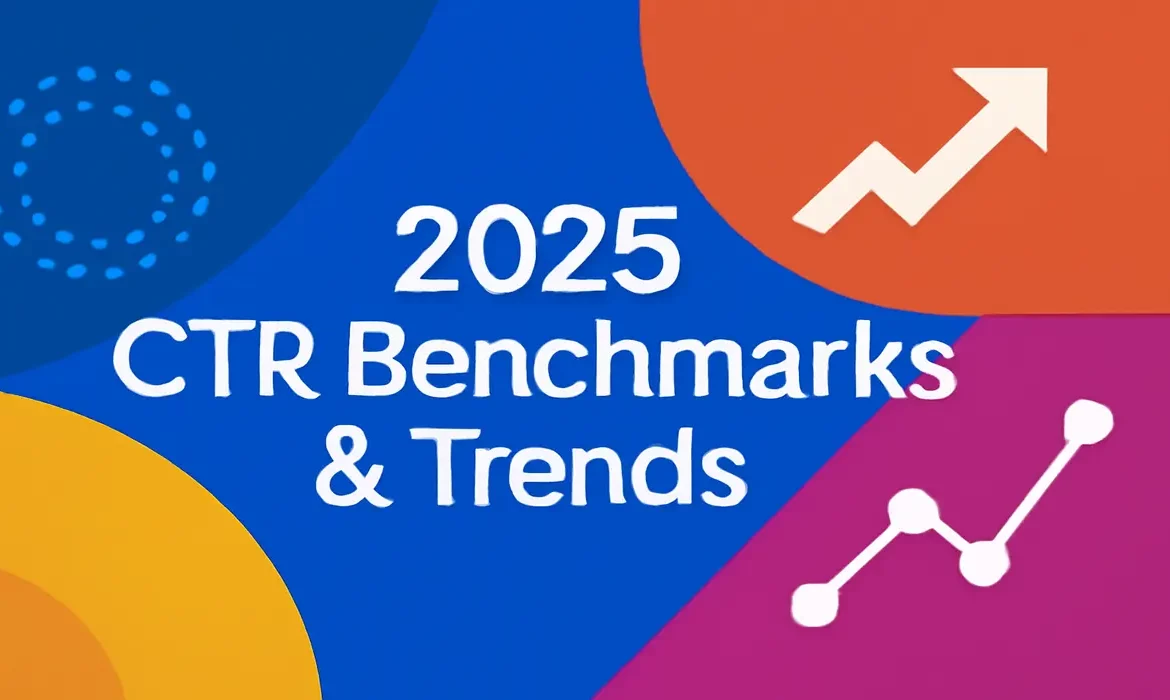
Your ads are live. Your reports look “fine.” Maybe even promising. But here’s the problem—you don’t know if they’re good… or just okay.
That’s where CTR plays a crucial role. It’s not just a number. It’s a signal. A live pulse on whether people care enough to click. Whether your creative is hitting the mark or just filling space.
And in 2025, that signal is more important than ever. With AI writing your headlines, algorithms picking your audiences, and attention spans racing to the next scroll, your click-through rate tells you something no tool can fake: real human interest.
We are breaking it down—what the latest CTR benchmarks look like by industry, what’s changed in the last year, and how to stay ahead of the curve in a landscape that’s getting smarter (and noisier) by the day.
Let’s make sure your ads are doing more than just running. Let’s make sure they’re working.
CTR in 2025 – Why This Metric Still Matters (Even in an AI World)
With AI writing ad copy, optimizing bids, and serving creatives in milliseconds, you might wonder—do metrics like CTR still matter?
Yes. More than ever. Because AI can automate the process, but it can’t fake interest. CTR is still the clearest way to measure whether your message actually lands with a real human being.
It cuts through the noise. A high CTR says, “Hey, this ad made someone stop, look, and click.” A low one? That’s a sign your targeting’s off, your message missed, or your creative didn’t hit the mark.
And in 2025, platforms are getting smarter about using CTR, too. Google’s AI now weighs historical CTR to influence your ad rank and Quality Score. Meta uses it to train its delivery algorithms. Even YouTube factors CTR into how it recommends videos.
So while AI might shape who sees your ad, it’s CTR that shows whether that view meant anything.
Here’s the simple formula to measure this metric:
CTR = (Clicks ÷ Impressions) × 100
What’s Changing in Digital Ad Performance (And Why CTR Isn’t Static Anymore)
If you’re comparing your CTR to last year’s benchmarks, stop right there because the game has changed.
In 2025, how people click—and why they click—isn’t what it used to be. And that’s thanks to three big shifts shaping the digital ad space.
1. AI-Driven Creatives Are Everywhere
From auto-generated headlines to dynamic visuals, AI is now crafting ad elements at scale. That means more versions, more tests, and wildly different CTRs depending on how well the AI was trained, or how much human editing was involved.
Bottom line? The creative bar has been raised. Your ad isn’t just competing with humans anymore—it’s up against algorithms too.
2. Smart Campaign Types Are Stealing Control
Google Performance Max. Meta Advantage+. These “all-in-one” campaign types optimize delivery using black-box machine learning. They decide where, when, and how your ads show—based on predicted performance.
What does that mean for you? CTR is no longer just a creative metric—it’s also a training input. If your early campaigns don’t perform well, the AI learns to deprioritize them.
3. Privacy Is Killing Granular Tracking
With cookies on the way out, platforms are shifting toward aggregated, anonymized reporting. That makes clicks one of the last user-level behaviors we can still track clearly, especially in retargeting and attribution.
So yes, CTR is still a core metric. But it’s not a fixed benchmark anymore.
It’s influenced by your tech stack, your targeting automation, your creative volume, and even your compliance setup.
The rules have changed. And to play smart in 2025, you need to stop treating CTR like a stable number—and start treating it like a moving target.
CTR Benchmarks by Industry – Search vs Display
What qualifies as a strong CTR depends on your industry, your audience, and the platform you’re using.
Search ads generally attract higher click-through rates than display ads because of intent. People on Google Search are actively looking. Display ads, on the other hand, interrupt, not always invite.
Still, benchmarks matter. They give you context. They help you spot gaps. And they can show whether you’re getting by or standing out.
Here’s how CTR typically plays out across different industries on both Google Search and Display:
| Industry | Avg. CTR (Search) | Avg. CTR (Display) |
| Advocacy | 4.52% | 0.60% |
| Arts & Entertainment | 10.88% | 0.48% |
| Automotive (Sales + Service) | 5.83% | 0.64% |
| B2B | 5.32% | 0.49% |
| Beauty & Personal Care | 6.14% | 0.76% |
| Career & Employment | 6.01% | 0.62% |
| Consumer Services | 2.51% | 0.50% |
| Dating & Personals | 6.23% | 0.74% |
| E-commerce | 5.68% | 0.53% |
| Education & Instruction | 6.45% | 0.54% |
| Finance & Insurance | 5.81% | 0.51% |
| Health & Medical | 3.34% | 0.58% |
| Home & Home Improvement | 4.73% | 0.52% |
| Home Goods | 2.49% | 0.50% |
| Industrial & Commercial | 5.74% | 0.48% |
| Legal Services | 4.37% | 0.57% |
| Real Estate | 8.29% | 1.12% |
| Restaurants & Food | 7.31% | 0.46% |
| Sports & Recreation | 8.76% | 0.52% |
| Technology | 2.17% | 0.41% |
| Travel & Hospitality | 4.59% | 0.49% |
These percentages aren’t fixed rules—they’re reference points. You might be above the average and still underperforming if your conversions don’t follow. You might be below the average and still getting ROI if your funnel is tight.
What matters is knowing where you are, identifying what’s holding clicks back, and making adjustments that align with your audience’s intent.
Email CTR Benchmarks – AI Meets Inbox
You write the perfect subject line. The email lands. It’s opened. But the real test? Whether they click.
That’s where CTR steps in. It shows how well your email drives action, not just attention.
A healthy click-through rate in email marketing usually lands between 1% and 5%, depending on your industry, offer, and audience. But it’s not just about numbers. It’s about what drives those clicks.
AI is playing a bigger role now. From writing subject lines to personalizing product recommendations, machine learning tools shape how emails look, when they are sent, and who gets what version.
But here’s the catch—automation means nothing without intent. You can segment lists and time sends perfectly, but you still miss the mark if your content doesn’t speak to what the user actually wants.
So, how do you boost email CTR? Focus on:
- Clarity over cleverness in CTAs
- Clean layouts that prioritize one action
- Behavioral triggers—send based on what users do, not just who they are
Also, keep an eye on CTOR (Click-To-Open Rate). It shows how many people clicked after opening. This filters out subject-line bias and gives you a clearer picture of your content’s pull.
Email may feel old-school, but it’s still a powerhouse. And CTR is the pulse that tells you whether your message is getting through or skipped.

Social CTR – YouTube, Meta, LinkedIn, and Beyond
Social ads don’t compete with other ads. They compete with everything—memes, baby photos, hot takes, breaking news. So, when someone stops and clicks your ad? That click means something.
CTR in social advertising reveals what grabs attention, builds interest, and earns engagement in a feed-first world. Here’s how it plays out across platforms:
YouTube
YouTube CTR often lands between 5% and 15%, depending on your niche.
It’s all about the thumbnail-title combo. If that preview doesn’t intrigue, people scroll or bounce.
Success on YouTube means pairing strong visuals with curiosity-driven headlines—and making sure the content delivers. CTR is your hook. But if the video disappoints, the algorithm stops showing it. Clicks and watch time go hand in hand.
A solid CTR on Facebook is around 2% to 5%. If you’re hitting more than that, your creativity and targeting are in sync.
What works? Motion-first visuals. Headlines that speak directly to pain points or desires. And custom audiences that reflect real behavior, not just demographics.
With Meta’s automation pushing Dynamic Creatives and Advantage+ campaigns, the algorithm learns fast, often in the first 24 hours. Early CTR trends can decide if your ad keeps scaling or stalls out.
Instagram’s CTR is slightly lower than Facebook’s, often 1% to 3% on average. But it thrives on aesthetics. It’s a visual-first platform, so polish matters.
Carousel ads, Reels with subtitles, and native-feeling Story creatives often outperform anything that feels too “salesy.” The best ads blend into the feed, then pop just enough to invite a tap.
LinkedIn CTRs are lower—usually 0.5% to 1.5%—but that’s not a weakness, it’s context.
This platform allows people to read slowly, evaluate deeply, and click with intent. Your ad might not rack up volume, but what clicks do you get? Usually high-value.
Thought-leadership content, event promotions, and B2B lead gen do especially well. Keep it concise. Keep it relevant. And speak to roles, not just industries.
Pinterest flies under the radar—but for certain industries, especially home, fashion, wellness, and DTC, it’s a goldmine.
CTR here can range from 0.7% to 2%. Visual storytelling wins. Think product in context, mood boards, and step-by-step guides. The platform is built around discovery, so native-style Pins that align with intent perform best.
Also Read: Color Psychology in Marketing: The Importance, Influence, and Implementations
Top 10 CTR-Boosting Moves That Still Work
Want better CTR? Stop guessing and start tweaking what actually matters. Here are ten proven moves—across platforms—that still drive real clicks today.
1. Match Message to Intent
People click when your ad solves what they’re already thinking about. Align your message with where they are in the buying journey—awareness, research, or decision.
2. Use Power Words, Not Filler
Replace weak CTAs like “Learn More” with sharper ones like “See It in Action” or “Unlock Your Offer.” Every word should push the user forward.
3. Get Visual. Fast.
Whether it’s a YouTube thumbnail or a Facebook carousel—your visuals do the first 80% of the work. Use bold contrast, motion, or curiosity to stop the scroll.
4. Experiment with Dynamic Creatives
On Meta and Google, let automation do some of the testing. Feed multiple versions of copy and visuals—then optimize based on what gets clicks.
5. Use First-Person Phrasing
Ads that feel like a conversation often perform better. Think: “I want this” or “Show me how.” It makes the experience personal.
6. Test Ad Formats, Not Just Messages
Some audiences click more on carousels. Others on video. Some need a static, no-frills banner. Don’t just change headlines—change how the message is delivered.
7. Tighten Your Targeting
Clicks drop when your ad lands in the wrong feed. Refine your custom audiences, update lookalikes, or test interest layers to get sharper.
8. Refresh Creative Regularly
Ad fatigue kills CTR. Even top-performing ads start to decay after a few weeks. Keep the concept alive, but remix how it’s shown.
9. Test Mobile-First CTAs
Most clicks now come from mobile. Buttons need to be bold. Text needs to be short. And the “next step” has to load fast.
10. Optimize for Load Time
Don’t let a slow landing page waste a good ad. If the experience post-click isn’t instant, your CTR won’t matter—users will bounce before they even see the offer.
Want to Outperform CTR Benchmarks? Let’s Fix the Whole Funnel
High CTR doesn’t come from lucky headlines or one good visual. It comes from alignment between your ad, offer, audience, and landing experience.
In other words, your whole funnel has to click before your customer ever does. That’s where we will help you.
At EvenDigit, we don’t just run ads. We engineer clicks that lead to conversions. From laser-focused PPC campaigns to scroll-stopping social ads, our approach is built to move metrics that matter, starting with CTR.
We’ve helped businesses across real estate, healthcare, education, e-commerce, B2B, travel, and more—consistently beat industry CTR benchmarks. We’ve run thousands of campaigns, tested millions of creatives, and know exactly what makes someone stop scrolling and click.
And we don’t stop at the ad level. We fine-tune audience targeting, ad sequencing, creatives, landing page flow, and even bidding strategy to get it right.
Our teams blend creativity with performance psychology, and our strategies are backed by real-time data, constant A/B testing, and channel-specific insights.
If you’re serious about outperforming your competitors, not just meeting the average, we should connect. Let’s rebuild your funnel to perform, not just participate.
EvenDigit
EvenDigit is an award-winning Digital Marketing agency, a brand owned by Softude (formerly Systematix Infotech) – A CMMI Level 5 Company. Softude creates leading-edge digital transformation solutions to help domain-leading businesses and innovative startups deliver to excel.
We are a team of 70+ enthusiastic millennials who are experienced, result-driven, and hard-wired digital marketers, and that collectively makes us EvenDigit. Read More




